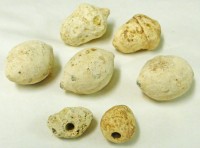Archaeologists studying Roman artillery at the ancient Roman battle site of Burnswark Hill in Dumfriesshire, southwest Scotland, have discovered that a type of sling-bullet that whistled when thrown. They believe this was a deliberate design intended to instill fear in enemy troops under assault.
Burnswark Hill is an Iron Age hillfort embraced by two Roman camps, one of the north slop, one of the south. The camps were first believed to be siege camps built to assault the fort, but in the 1960s some archaeologists postulated they might instead be training camps. There are references in ancient sources to the assiduous Roman training procedures, but evidence of them in the archaeological record is almost impossible to pinpoint. Training exercises could be the reason for the large number of Roman projectiles — 130 lead sling-bullets, 11 ballista shots, nine iron arrowheads — found on Burnswark Hill in earlier excavations.
 Initial research found that the bullets, cast from lead and thrown with a sling apparatus, came in two main varieties: type I, larger and lemon-shaped, and type II, smaller and acorn-shaped. When Dr. John Reid of the Trimontium Trust secured a grant from the Heritage Lottery Fund to survey and dig the site, his team found a third type: a small oblong in which a hole had been drilled on one side. The type III bullets weigh 20 grams (type I goes up to 60 grams) and the holes are just .5 mm in diameter. They are all the same standard size.
Initial research found that the bullets, cast from lead and thrown with a sling apparatus, came in two main varieties: type I, larger and lemon-shaped, and type II, smaller and acorn-shaped. When Dr. John Reid of the Trimontium Trust secured a grant from the Heritage Lottery Fund to survey and dig the site, his team found a third type: a small oblong in which a hole had been drilled on one side. The type III bullets weigh 20 grams (type I goes up to 60 grams) and the holes are just .5 mm in diameter. They are all the same standard size.
Drilling holes in cast lead is time and labour-intensive for a projectile that is going to be thrown and almost certainly lost. It also lightens the ball which means it will cause less damage in a direct hit. Reid at first considered whether the holes might have been used to deliver poison, a form of early chemical warfare, but his brother had a better idea.
Reid’s brother, a keen fisherman, offered some insight into their possible purpose when he suggested the bullets were designed to make noise in flight.
“I said, ‘Don’t be stupid; you’ve no idea what you’re talking about. You’re not an archaeologist,'” Reid joked. “And he said, ‘No, but I’m a fisherman, and when I cast my line with lead weights that have got holes in them like that, they whistle.'”
“Suddenly, a light bulb came on in my head — that’s what they’re about. They’re for making a noise,” Reid said.
Experiments with replica bullets and slings confirmed that Reid’s brother was onto something. They were useless for holding poison. The hole was tiny and there was no guarantee the small, ballistically inferior bullets would even penetrate the skin. While flying towards their targets, however, the projectiles did make a whistling or high-pitched buzzing noise like an irate bee. The replica experiments also confirmed that the bullets could be successfully thrown in small clusters of three or four for a grapeshot effect.
The point of the sound was to intimidate and make the enemy crouch down or dodge around in the attempt to avoid the strike. If you throw a projectile and it hits, you take out a guy, but if you throw a projectile and it makes a sound as it approaches, anyone in the line of fire is going to duck or dodge reflexively. In a full-on assault, the missile storm would generate a huge amount of noise as hundreds, even thousands of bullets whistled toward the enemy lines.
It total, the Burnswark Project found 700 sling-bullets, more than have been found on any other Roman battlefield in Europe. The projectiles ranged over a full half kilometer (third of a mile) across the battle front. The type III bullets are unique. They have been found on no other Roman battlefields. Examples of pierced sling-bullets have been found on Greek battlefields from the second and third centuries B.C., but they were ceramic, not cast from lead.
The Burnswark Project findings do not support the training camp theory. That high of an expenditure in effort and materiel would be wasteful in training. Reid believes the fort on Burnswark Hill was targeted by a sustained Roman attack probably during the reign of Antoninus Pius who went north of Hadrian’s famous border wall in an attempt to conquer Scotland. He did gain some ground — see the Antonine Wall — but Roman legions retreated to Hadrian’s Wall in less than a decade.
Dr. Reid’s full article on the Burnswark project, “Bullets, Ballistas, and Burnswark,” is available in the print edition of Current Archaeology. There’s a tantalizing exerpt of the beginning of the article on the magazine’s website. There’s also a cool drone flyover video of Burnswark Hill with Roman fortlet and camps labeled. There are sheep on the Roman north camp now and I don’t think they don’t like the drone much.
[youtube=https://youtu.be/GTJb0gaZMkE&w=430]
Here’s a recording of the sounds the replica type III bullets made when thrown with a replica sling. The thwack-pew combination is pretty badass. It would surely have been scary hurtling at you or whizzing past you, downright terrifying when multiplied by hundreds.
[audioplayer file=”http://www.thehistoryblog.com/wp-content/uploads/2016/06/Bullets-sound.mp3″ titles=”Type III bullets whistle when thrown”]